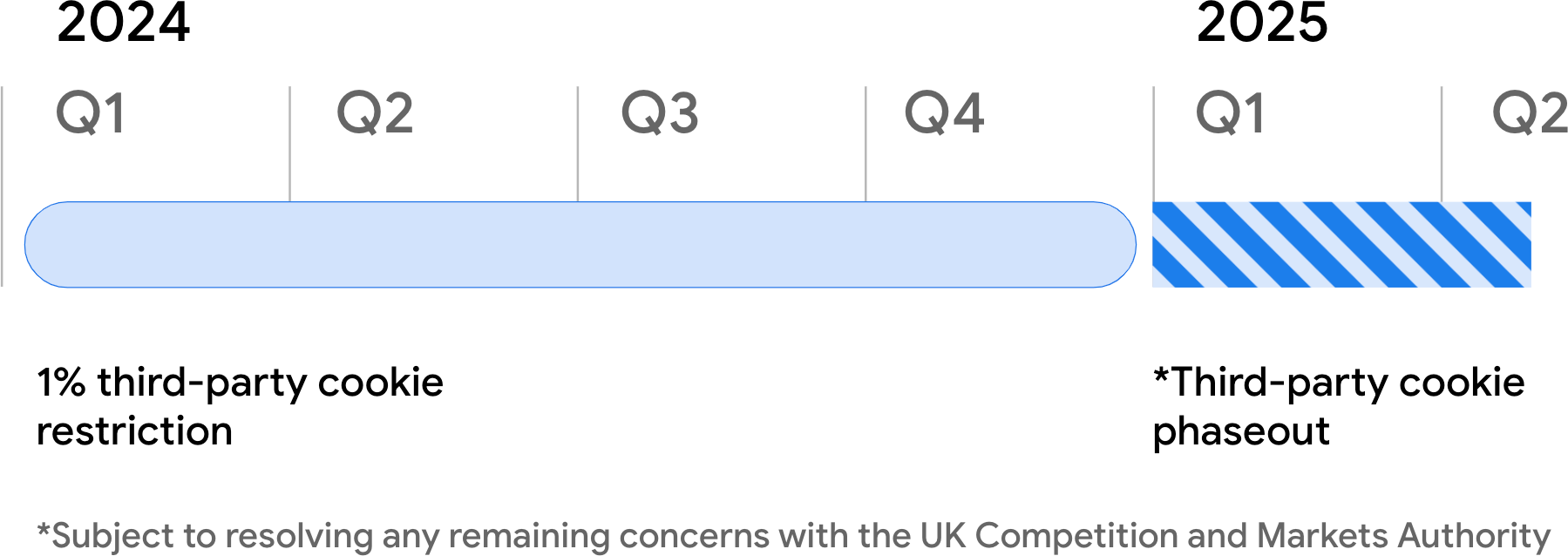The death of third-party cookies: How to future-proof your strategy for a cookieless world

The landscape of digital advertising is about to undergo a massive shift. Google’s Privacy Sandbox initiative is phasing out third-party cookies. Currently, about 1% of Chrome users (around 30 million people) are already testing the new tracking protection feature, which limits access to third-party cookies by default. Google expects to fully phase out third-party cookies by early 2025. What does this mean for your advertising strategy? How can you adapt to stay effective? Let’s get ready for this shift together!
How will the third-party cookies deprecation impact your advertising strategy?
Let’s zoom out and explore the ways in which the phase-out of third-party cookies is going to shake up your advertising game. Here are some of the key areas of impact:
- Cross-Site Tracking: Say goodbye to smoothly tracking users across different websites. With third-party cookies out of the picture, it’s like navigating in the dark, trying to piece together fragmented data to understand user behavior.
- Targeting & Retargeting: Without those detailed user profiles, targeting the right audience becomes trickier. Get ready for higher ad costs and looking for new ways to reach potential customers.
- Measurement & Attribution: Tracking campaign performance? It’s going to be a bit like trying to hit a moving target. Marketers will need to get creative to accurately measure and attribute their efforts in this new landscape.
- Frequency Control: With third-party cookies on the out, controlling how often users see your ads is going to be a challenge. Anticipate some fatigue and having to rethink how to engage your audience without spamming them.

How do you survive without third-party cookies?
To thrive without third-party cookies, you’ll need revamp your data strategy and pivot to a first-party data approach, and encourage your audience to willingly share their information. Why is first-party data your secret weapon in navigating a cookieless future?
- Ownership: You gather this data directly from your audience, so you own it.
- Accuracy: These insights are the most precise you can gather about your customers, making them invaluable for personalization.
- Consent: Collecting this data requires consent from subscribers and visitors, ensuring privacy compliance.
5 steps to take to achieve a first-party data strategy

- Identify your goals
What are your organization’s key marketing objectives? Which ones specifically require first-party data? It’s about establishing measurable goals and specifying the data required to achieve them. For instance, your organization’s primary goal might be to boost customer retention or conversion rates.
2. What data matters?
Once you have a clear understanding of your goals it’s time to ask yourself: Which first-party data is essential? What truly matters? Based on your goals, you may want to know:
- How users engage with your website or app.
- Interactions with your social media posts, including comments and likes.
- Demographic information such as location, age, and gender of your audience.
- Frequently asked questions from your customers.
- The products or services your customers have purchased
A good idea is to begin with an audit of the data you’re currently collecting. Chances are you already have valuable insights that can enhance your marketing efforts. By understanding what you possess you can identify gaps and strategize ways to enhance your outreach.
3. Define your data sources
Now you’ve clarified your goals and the specific data you require, the next step is determining where to access this data. There are several sources you can use, of which some of the most common are:
- Purchase history
- Behaviors or actions from your website, app, product
- Social media engagement data
- Emails or Newsletter interaction
- SMS interactions
- Customer feedback
- Customer service chats
- CRM
4. Assess your internal resources:
Do you have the talent and technological infrastructure necessary to execute a successful first-party data strategy? Is your company equipped to store and manage large volumes of data? Are there the right in-house skills in your organization? Are there any gaps in your teams in terms of data collection, analysis, and data management skills? Do you have a marketing data specialist for the analysis, segmentation, and campaign optimization? List your deficiencies to identify what’s feasible in the short and long term.
5. Collect the data
Ensure Implementation of data collection mechanisms across customer touchpoints. Some of the most effective methods include:
- Conducting incentivized surveys
- Encouraging users to provide data willingly by offering gated content through lead generation campaigns
- Prompting visitors to create accounts on your website
- Utilizing web forms to capture user data.
- Requesting feedback and reviews
How to leverage first-party data in your advertising strategy
Now we’ve discussed how to collect first-party data, let’s explore how to use it to enhance your accounts for better audience targeting and performance tracking.
- Customer match or audience uploads: This isn’t groundbreaking, but major ad ads platforms such as Google and META enable you to import your CRM customer data to match with logged-in users. Consequently, any customer information you collect can be utilized to track and build targetable user audiences later on.
- Enhanced conversions (Google Ads): this feature helps advertisers in monitoring how effectively ads prompt actions on websites, such as purchases or sign-ups. Enhanced Conversions enable you to monitor user activity on your website following clicks on your Google ads. The process ensures that data remains private and anonymous, adhering to privacy regulations.

- Conversion API (Linkedin Ads and Meta Ads)
This is privacy-preserving technology that tracks user actions such as purchases or sign-ups directly from your server to ad platforms, bypassing third-party cookies and browser settings. It’s increasingly favored amidst privacy changes and adopted by major platforms Metan and LinkedIn.
This server-side approach syncs website data, CRM leads, phone call interactions, in-person conversions, and in-store purchases, providing a comprehensive view of the customer journey. It establishes a direct link between your marketing data (web, app, and offline) and platforms like Meta and LinkedIn, enhancing ad performance without relying on browser cookies.

If you’re wondering whether Conversion API should replace Pixel (Meta) and Insight Tag (LinkedIn) tracking methods, the answer is no. Instead of choosing one or the other, you should combine them to maximize efficiency. Using both the Insight Tag / Pixel and Conversion API creates redundancy in tracking mechanisms, enhancing system resilience by preventing data loss. The Insight Tag excels in on-site user behavior tracking, while the Conversion API is effective for off-site actions. Together, they offer comprehensive tracking across a broad spectrum of user interactions, boosting overall insights and effectiveness.
How do you find new users to target without third-party cookies?
But what about the other side of the problem? How do you even find the users to target in the first place without relying on third-party cookies?
That’s where AI and machine learning come to the rescue. All the major ad platforms are rolling out features to help advertisers reach new users using AI and machine learning. Take Meta’s Advantage+ Audience, for example. This is a targeting feature that uses AI to determine the most relevant audience for your ads. Meta’s systems are always learning from your pixel data and conversions, like purchases, leads, content views, add-to-cart actions, and registrations.
And then there’s LinkedIn’s predictive audiences. This feature helps you expand your campaign’s reach by creating an audience that’s likely to take actions similar to those in your source data. LinkedIn combines your data with its AI to automatically generate a new custom audience for your campaigns.
Last but not least, there are also other strategies to reach your potential customers without relying on cookie tracking, focusing instead on content relevance, partnerships, and influencer reach.
Contextual ads, for instance, are online ads served to viewers based on the content or page they are currently viewing, rather than user data like location or demographics. In a world without cookies, this approach is more effective than behavioral ads. If you’re on the style page of a news website, you might see ads for clothing brands: this is contextual advertising.
Think about which websites your target audience visits. What similar products or services are they searching for? Are there blogs, influencers, or forums where your customers hang out that you can be present on? Setting up strategic partnerships can help you run ads in the right places, even without using cookies.
Shift your data strategy to power your ads. It’s your party!
it’s all about embracing first-party data as a new strategy for acquiring customer and prospect information. Combine your data with advertising technology that respects privacy and leverage AI and machine learning to find new audiences without relying on third-party cookies. By doing so, you can create more personalized and effective marketing campaigns that drive growth.
This article is an adaptation of a talk Giorgia originally delivered at the Search & Social Advertising Show, Brighton, in April 2024.



